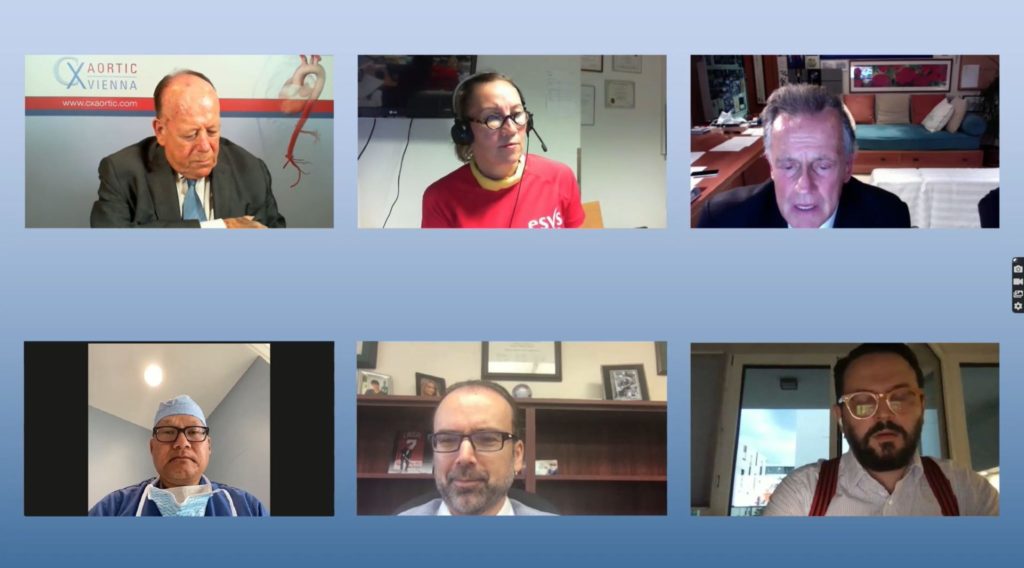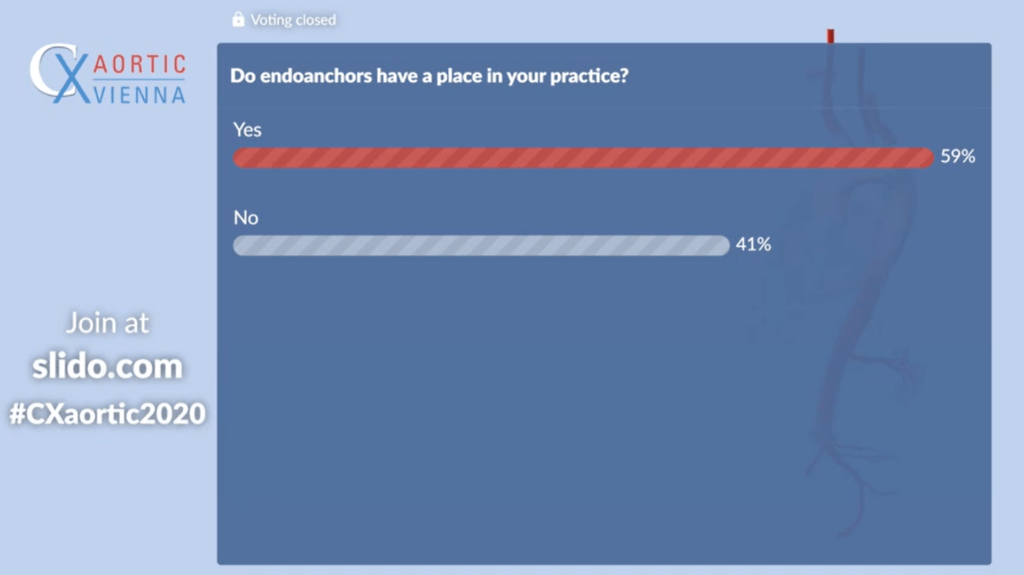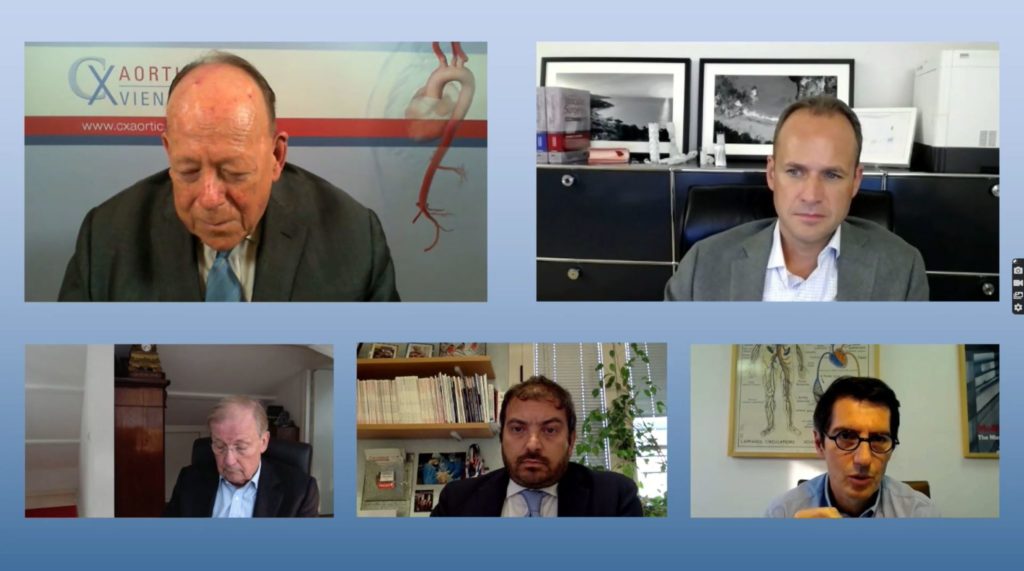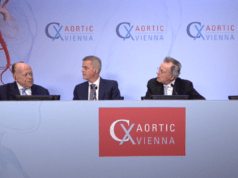
In the final session of the inaugural CX Aortic Vienna meeting, Maarit Venermo (Helsinki, Finland), and Roberto Chiesa (Milan, Italy) steered the audience through animated discussion on thoracic endografts and thoracoabdominal repair.
This session, and all other sessions from day four of CX Aortic Vienna, are available to view on demand. Click here to register and access the recording of the first session on thoracic endografts, and here for the second.
Jason Lee (Stanford, USA) and Ali Khoynezhad (Manhattan Beach, USA) enlivened proceedings with a CX debate on the following motion: snorkels and parallel endografts enabling perfusion of branch vessels and extensions of endograft utility along the whole thoracoabdominal aorta are useful. Lee argued in favour of the motion, and Khoynezhad against.
In Lee’s eyes, snorkel, chimney, periscope, and sandwich techniques are “likely all here to stay,” particularly when it comes to urgent cases, bailout, and difficult anatomy “that cannot be managed with commercially-available, current devices in the USA”.
Arguing against this, Khoynezhad told the listening audience that parallel grafting “has many pitfalls and complications”, and shared that this method comes with a higher mortality when compared to a propensity-matched cohort. “Parallel grafts are an acceptable approach in emergency cases or as a bailout manoeuvre,” he concluded.
CX Aortic Vienna audience vote snorkles and parallel endografts are useful, but not the best option
 Audience polling conducted after the debate revealed that while 83% of the audience believe snorkles and endografts enabling perfusion of branch vessels and extensions of endograft utility along the whole thoracoabdominal aorta are useful, 82% believe they are not the best method.
Audience polling conducted after the debate revealed that while 83% of the audience believe snorkles and endografts enabling perfusion of branch vessels and extensions of endograft utility along the whole thoracoabdominal aorta are useful, 82% believe they are not the best method.
Following the debate, Roman Gottardi (Salzburg, Austria) provided a summary of the current trends in reduction or elimination of aortic impulse during stent graft deployment and balloon moulding in TEVAR. According to Gottardi, the preferred methods of reduction and elimination of aortic impulse during TEVAR are rapid right ventricular pacing and pharmacologic blood pressure lowering, which are less frequently used for balloon moulding.
Spinal cord ischaemia and the place of cerebrospinal fluid drainage addressed

Turning to spinal cord ischaemia in the context of thoracoabdominal repair, Gustavo Oderich (Houston, USA) spoke to the CX Aortic Vienna audience that cerebrospinal fluid drainage “is a key component of treatment of spinal cord injury”, but noted that evidence for efficacy of routine prophylactic drainage is “at best weak”. He called for a prospective randomised study of prophylactic versus rescue cerebrospinal fluid drainage.
Anchor chair Roger Greenhalgh (London, UK) remarked that it was not the first time this had been said, citing similar discussions in previous years with the likes of Stanley Crawford.
Corinna Walter (Vienna, Austria) spoke next, discussing perioperative antithrombotic management and cerebrospinal fluid drainage in TEVAR. The more extensive the aortic coverage in any form of EVAR, the greater the risk of spinal cord ischaemia, she explained, adding that “There are multiple different approaches to reduce the risk of spinal cord ischaemia.” As described in detail in her talk, the team of which Walter is part have been successfully employing an antithrombotic regimen to minimise this risk, and she reported a 96% patency rate of visceral stent grafts “without a single case of spinal haematoma”—no cerebrospinal fluid drainage, and no catheter-related bleeding complications.
Having heard about the challenges presented by spinal cord ischaemia, the CX Aortic Vienna audience were given a presentation delineating the “best protocol” for preventing the complication. Wrapping up the online conference, Germano Melissano (Milan, Italy) related how spinal cord ischaemia is “multifactorial”, and that its prevention “requires optimising all aspects of procedures”. However, after detailing the steps his institution implements to avoid spinal cord ischaemia, he concluded that, while cerebrospinal fluid drainage is a valid adjunct, “it comes with several potential serious complications. The problem is not yet solved,” he said, “more research is needed.”
In response to a final poll concluded the session, asking the audience “Can we safely predict when not to use spinal cord drainage?” a majority (88%) voted “no”.
Further discussion: Thoracic endograft and throracoabdominal repair

Alexander Zimmermann (Zurich, Switzerland), Marek Ehrlich (Vienna, Austria) moderated another session on thoracic endograft and thoracoabdominal repair.
Matt Eagleton (Boston, USA), programme committee co-chair of the Society for Vascular Surgery (SVS) asked the CX Aortic Vienna audience “Are we making a difference [concerning long-term survival] with F/BEVAR?” He believes so, telling delegates that F/BEVAR “has improved survival compared to non-operative management in most patients, even in a high-risk patient population”.
Frans Moll (Utrecht, The Netherlands) opened the first session, addressing the audience with a talk arguing that a more compliant thoracic stent graft is needed. “Aortic stiffening is known to play an important role in cardiovascular disease,” he said, “and as we know, endografts induce stiffening of the aorta.” He concluded: “To overcome this issue, medical device manufacturers should work hand-in-hand with the surgeons to develop more compliant devices to reduce this stiffness mismatch with the aorta, especially when treating aortic pathologies in the proximal aorta, close to the aortic valve and in younger patient populations. This is an important issue to work on in the near future.”
Andrea Kahlberg (Milan, Italy) next shared his experience of more than 300 TEVAR procedures using the Zenith Alpha thoracic stent graft (Cook Medical), a low-profile modular endograft system. Kahlberg shared how this stent graft allowed his team to extend indications to patients with severe access problems, enabling safe passage through calcified and tortuous vessels. “It retains the precision and control of the previous generation device, but with higher conformability,” he enthused. “It has provided satisfactory mid-term results in our single-centre series.”
Discussing branched endografts for rupture chronic thoracoabdominal dissections, Stéphan Haulon (Paris, France) next took to the online podium. “I think that high-volume centres should be able to perform both techniques, open and endovascular repair of chronic dissections,” he said. “When using T-branch in chronic dissections, you need vast experience with complex iliac branch and fenestrated endografting,” he recommended.
“Zone two extension is needed in up to 60% of TEVAR patients,” Gustavo Oderich (Houston, USA) concluded in his talk on left subclavian artery preservation during thoracic endovascular repair. Sharing his preliminary experience with left subclavian artery branch devices, he showed how these early results indicate low morbidity and stroke rates with high patency rates. He reminded delegates that left subclavian artery coverage without revascularisation is associated with higher risk of arm ischaemia, posterior circulation events, and spinal cord injury.
Fabio Verzini (Turin, Italy) presented on fenestrated and branched endografting for post-dissection thoracoabdominal aneurysms. “Thoracic endografting has been used as a minimally invasive solution for chronic type B aortic dissection, with favourable early results,” he said. “Unfortunately, high risk of late reintervention has been found, ranging from between 0 and 20%.”













